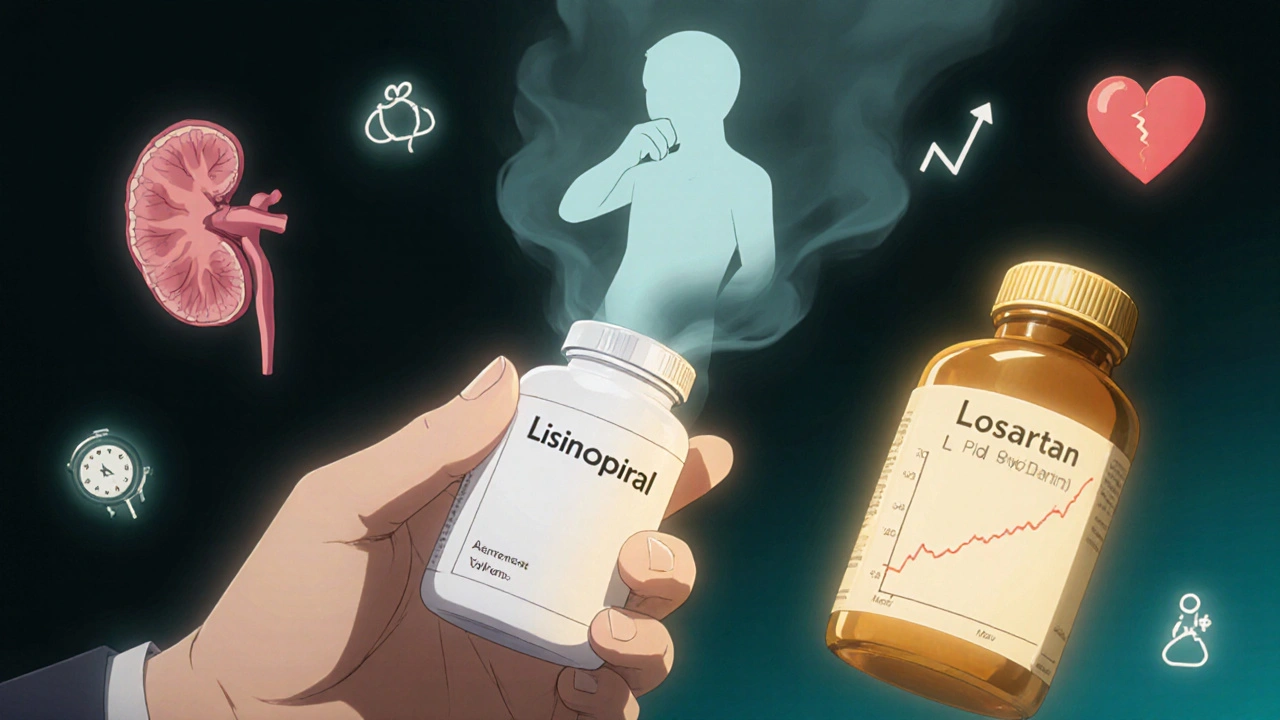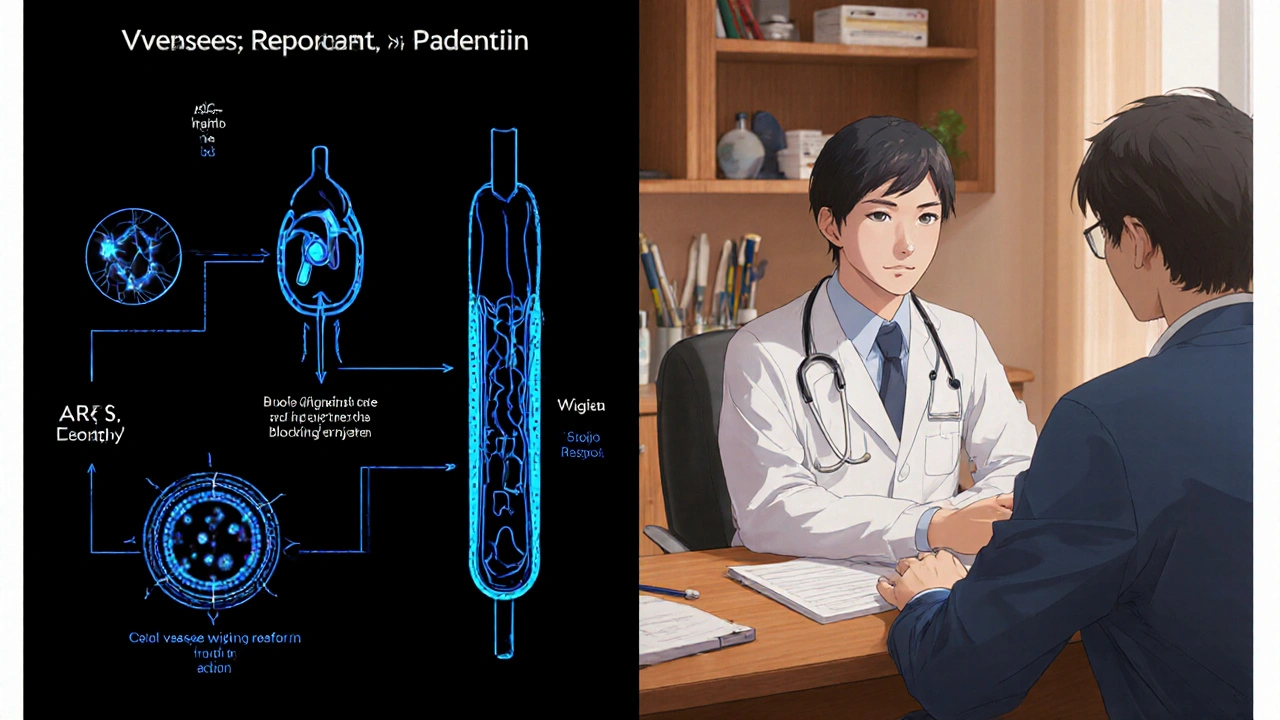High blood pressure doesn’t care how busy you are, how much you exercise, or how healthy you eat. If your doctor prescribed Zestril - the brand name for lisinopril - you’re not alone. Millions take it every day. But maybe it’s giving you a dry cough. Or maybe your insurance raised the price. Or you just want to know if there’s something better. That’s fair. There are plenty of alternatives to Zestril, and not all of them work the same way.
What Zestril (Lisinopril) Actually Does
Zestril is an ACE inhibitor. That means it blocks an enzyme your body uses to make angiotensin II, a chemical that narrows blood vessels. Less angiotensin II = wider vessels = lower blood pressure. It also helps your kidneys get rid of extra salt and water, which takes pressure off your heart.
Lisinopril is taken once a day. It starts working within an hour, but it can take weeks to reach its full effect. It’s often used for people with heart failure, after a heart attack, or with kidney problems from diabetes. It’s cheap, generic, and has been around since the 1980s. But it’s not perfect.
Common Side Effects of Zestril
Most people tolerate lisinopril fine. But about 1 in 10 people get side effects. The most common? A dry, tickly cough - no mucus, no fever, just constant irritation. It’s not dangerous, but it’s annoying enough that many people stop taking it.
Other possible side effects include:
- Dizziness, especially when standing up
- High potassium levels (can be dangerous if not monitored)
- Swelling of the face, lips, or tongue (rare, but needs emergency care)
- Low blood pressure (too much, not just right)
- Kidney function changes (usually mild, but needs checking)
If you’re getting a cough or feel lightheaded most mornings, it’s not just "getting used to it." It’s your body telling you something else might work better.
Top Alternatives to Zestril
You don’t have to stick with Zestril if it’s not working for you. Here are the most common alternatives - and how they stack up.
1. Enalapril (Vasotec)
Another ACE inhibitor, just a different molecule. It’s very similar to lisinopril in how it works. But enalapril needs to be taken twice a day. That’s a hassle for people trying to keep a simple routine. It also causes the same dry cough. So if you’re on Zestril because you want once-daily dosing, enalapril won’t help.
2. Ramipril (Altace)
Like lisinopril, ramipril is taken once daily. It’s often used after heart attacks and in people with diabetes. Some studies suggest it might protect the kidneys slightly better than lisinopril. But again - same risk of cough. It’s not a true alternative if the cough is your main issue.
3. Losartan (Cozaar)
This is where things change. Losartan is an ARB - angiotensin II receptor blocker. It does the same job as ACE inhibitors but at a different point in the pathway. It doesn’t cause the dry cough. That’s huge. If your cough is the reason you want to switch, losartan is your best bet.
It’s also less likely to cause swelling (angioedema), which is rare but serious with ACE inhibitors. Losartan is now generic and costs about the same as lisinopril. Many doctors start new patients on losartan now just to avoid the cough risk.
4. Valsartan (Diovan)
Another ARB, similar to losartan. It’s often used for heart failure or after a heart attack. It’s taken once daily. Some people find it causes less dizziness than ACE inhibitors. But it’s usually more expensive unless you’re on a generic plan. Worth considering if losartan didn’t work well for you.
5. Amlodipine (Norvasc)
This one’s different. It’s a calcium channel blocker, not an ACE inhibitor or ARB. It works by relaxing the muscles in your blood vessel walls. It doesn’t cause cough. It doesn’t raise potassium. It’s great for older adults and people of African or Caribbean descent, who often respond better to calcium channel blockers than ACE inhibitors.
Amlodipine can cause swollen ankles or flushing, but those are usually mild. It’s also very cheap and taken once a day. Many doctors now combine it with an ARB if one drug isn’t enough.
6. Hydrochlorothiazide (HCTZ)
This is a diuretic - a water pill. It helps your body get rid of extra salt and water. It’s often used in combination with other blood pressure drugs. Alone, it’s not as strong as ACE inhibitors for most people. But when paired with an ARB like losartan, it works really well. It’s inexpensive and has been used for over 60 years.

Comparison Table: Zestril vs. Top Alternatives
| Medication | Class | Dosing | Cough Risk | Cost (Generic) | Best For |
|---|---|---|---|---|---|
| Zestril (Lisinopril) | ACE Inhibitor | Once daily | High | $5-$10/month | Diabetes, heart failure, post-heart attack |
| Enalapril | ACE Inhibitor | Twice daily | High | $5-$10/month | Cost-sensitive, but not for those with cough |
| Ramipril | ACE Inhibitor | Once daily | High | $10-$15/month | High-risk kidney patients |
| Losartan | ARB | Once daily | Very Low | $5-$10/month | People with ACE inhibitor cough |
| Valsartan | ARB | Once daily | Very Low | $15-$30/month | Heart failure, if losartan fails |
| Amlodipine | Calcium Channel Blocker | Once daily | None | $5-$10/month | African/Caribbean descent, older adults |
| Hydrochlorothiazide | Diuretic | Once daily | None | $3-$8/month | Combination therapy, mild hypertension |
When to Switch from Zestril
You don’t need to switch just because you’re curious. But here are clear signs it’s time to talk to your doctor:
- You have a persistent dry cough that started after starting Zestril
- You’ve had swelling in your face or throat (even once)
- Your blood pressure isn’t dropping despite taking it regularly
- You’re taking it with other meds that raise potassium (like potassium supplements or NSAIDs)
- It’s too expensive and you can’t afford it, even with coupons
If any of these apply, don’t stop on your own. Talk to your doctor. They can switch you to a safer, more comfortable option.

What Most Doctors Recommend Now
In 2025, guidelines from the American Heart Association and the UK’s NICE recommend starting with either an ARB (like losartan) or a calcium channel blocker (like amlodipine) for most people with high blood pressure - especially if they’re Black or over 55.
ACE inhibitors like Zestril are still used, but mostly for people with diabetes or heart failure. For the average person with high blood pressure, losartan or amlodipine often come first now. Why? Fewer side effects, better tolerance, and just as effective.
One 2024 study of over 120,000 patients found that those switched from lisinopril to losartan due to cough had a 72% drop in cough-related doctor visits in the next six months. No change in blood pressure control. Just better quality of life.
What You Should Do Next
Don’t make this decision alone. But here’s what you can do today:
- Write down how you feel on Zestril. Cough? Dizziness? Swelling? Fatigue?
- Check your last blood test results - especially potassium and kidney function.
- Look up your prescription cost. Is it still affordable? Can you get the generic?
- Make a list of what matters most: once-daily dosing? No cough? Lowest price? Kidney protection?
- Bring this list to your next appointment. Say: "I’ve been on Zestril, but I’m wondering if another option might suit me better. What do you think?"
There’s no "best" drug for everyone. But there is a best drug for you. And you deserve to feel good while managing your blood pressure.
Can I switch from Zestril to losartan on my own?
No. Never stop or switch blood pressure medications without your doctor’s guidance. Stopping suddenly can cause your blood pressure to spike, which is dangerous. Your doctor will help you taper off safely and start the new medication at the right dose.
Is losartan better than lisinopril for kidney protection?
Both are good for kidney protection in people with diabetes. Some studies show losartan may have a slight edge in reducing protein loss in urine, but the difference is small. The biggest advantage of losartan is avoiding the dry cough, not better kidney outcomes.
Why do some people say amlodipine works better than Zestril?
People of African or Caribbean descent often respond better to calcium channel blockers like amlodipine than to ACE inhibitors. This isn’t about race - it’s about how the body naturally regulates blood pressure in different populations. If you’re in this group and Zestril didn’t work well, amlodipine is often the first choice.
Can I take Zestril and losartan together?
No. Taking two drugs from the same class - like two ACE inhibitors or an ACE inhibitor and an ARB - increases the risk of very low blood pressure, kidney damage, and dangerously high potassium. Doctors avoid combining them unless under very specific, monitored conditions.
Is there a natural alternative to Zestril?
There’s no herbal supplement or diet that replaces Zestril for controlling high blood pressure. Things like garlic, beetroot juice, or magnesium might help a little, but not enough to replace medication. If you want to reduce your pill burden, talk to your doctor about lifestyle changes - diet, salt reduction, exercise - and whether you can lower your dose safely.
How long does it take for a blood pressure med to work after switching?
It usually takes 1 to 2 weeks for a new blood pressure medication to reach its full effect. You might feel better sooner, but don’t assume it’s working until you’ve had your blood pressure checked. Your doctor will likely want to see you back in 2-4 weeks after switching.






Reviews
Finally, someone broke this down without sounding like a drug rep. I was on lisinopril for two years-dry cough so bad I’d wake up gasping. Switched to losartan and it was like someone turned off a fire alarm in my throat. No more 3 a.m. coughing fits. Also, my potassium stayed normal. Doctors act like ACE inhibitors are holy, but if it makes you miserable, it’s not working for YOU.
PS: I still do yoga and eat kale. But meds aren’t optional. Don’t let anyone shame you for needing them.
Just want to say-this post is a godsend. I’ve been Googling for hours trying to figure out why my BP won’t drop. I had no idea amlodipine was better for people of Caribbean descent. My dad’s from Jamaica and he’s been on Zestril for 10 years… I’m printing this out and handing it to his cardiologist tomorrow. Thank you for the table too-so much clearer than those bloated PDFs.
Also, yes-NO combining ARBs and ACE inhibitors. I saw a guy on Reddit who did it ‘to be extra safe’ and ended up in the ER. Don’t be that guy.
Of course the post says ‘don’t switch on your own’-because the pharmaceutical industry wants you dependent. Did you know lisinopril was originally developed by a company that later merged with Pfizer? Coincidence? I think not. The cough? That’s not a side effect-that’s your body rejecting the chemical sludge. Try hawthorn berry. Or fasting. Or just… stop.
Also, ‘generic’ is just a marketing word. The active ingredient is the same, but the fillers? Different. That’s why you feel worse on the ‘cheaper’ version.
Sam, I hear you’re frustrated-but this isn’t the place for conspiracy theories. People rely on this info to make health decisions. If you’ve had bad experiences with meds, I’m sorry. But pushing unproven alternatives risks lives. Let’s keep this space safe for real advice.
Also-Ellen, your comment about the cough? That’s exactly what I needed to hear. Thank you.
As someone who’s lived in both the US and the UK, I’ve noticed a stark difference in prescribing habits. In the UK, NICE guidelines are followed almost religiously-ARBs and CCBs first, ACE inhibitors only if indicated. In the US, it’s still ‘lisinopril until proven otherwise.’ It’s frustrating. This post aligns with global best practices. Maybe more doctors here need to read it.
Also, the 72% drop in cough-related visits? That’s not a fluke. That’s data. And data > tradition.
Let me tell you, I’ve been on every blood pressure med under the sun-lisinopril, valsartan, amlodipine, HCTZ, even that weird one with the long name that tastes like metal. I’m 68, had a mild stroke in ’19, and now I’m on a combo of losartan and amlodipine. Here’s the thing: it’s not about the drug. It’s about your body’s rhythm. I tried switching meds every six months ‘to see what stuck.’ Bad idea. Took me two years to find the combo that didn’t make me feel like a zombie or a balloon.
Don’t chase the ‘best’ drug. Chase the one that lets you sleep, walk the dog, and not stare at the ceiling at 3 a.m. wondering if your kidneys are failing. That’s the winner. And yes-get your potassium checked. Every. Single. Time. I once went from 4.2 to 6.1 in three weeks because I started taking potassium supplements ‘for energy.’ Ended up in the ER. Don’t be me.
Y’all are missing the real win here: amlodipine doesn’t make you feel like you’re being slowly squeezed by a giant hand. I was on lisinopril for six months-dizzy every morning, coughing like I had TB, and my ankles looked like inflated balloons. Switched to amlodipine. First day? Felt like I’d been given a new pair of legs. No cough. No dizziness. Just… normal. My grandma’s 82, Haitian, and she’s been on amlodipine for 15 years. Still gardening. Still cooking jerk chicken. Still alive.
And yes, it’s $5. At Walmart. With a coupon. I’m not even mad anymore. Just grateful.
It’s fascinating how medicine has become a cult of compliance. We’re told to take pills, check labs, follow guidelines-yet no one asks why we’re sick in the first place. High blood pressure isn’t a disease. It’s a symptom of disconnection-from food, from movement, from community. The real alternative to Zestril isn’t losartan-it’s silence. Quiet mornings. No screens before bed. Walking barefoot on grass. The body knows how to heal. We just forgot to listen.
Also, the table? It’s beautiful. But it’s still a cage. You’re still choosing between different flavors of control. True freedom is not needing any of them.
Losartan? That’s just lisinopril with a new label. Same company. Same profit margins. The cough? That’s the body detoxing. The real danger is the potassium spike-they want you on more meds to fix the meds. I stopped all pills. Started drinking pickle juice. My BP dropped. My energy soared. No more dizziness. No more pharmacy trips. The system hates this. But I’m alive. And I didn’t pay a dime.
They’ll never tell you this. But you’re reading it now.
Guys-just talk to your doctor. Seriously. I was scared to ask about switching because I thought they’d think I was a hassle. Turns out? They’re relieved. I told mine I wanted to avoid the cough and keep it cheap. He said, ‘Perfect. Let’s go with losartan.’ Done in 10 minutes. No drama. No judgment. Just a human who wants you to feel better.
Also, the cost thing? I got my generic losartan for $3 at Costco. No insurance needed. So stop stressing about price. It’s cheaper than your coffee habit.
Irrespective of the pharmacological nuances, the empirical evidence presented herein is both statistically significant and clinically relevant. The assertion that ARBs supersede ACE inhibitors in terms of tolerability is corroborated by multiple meta-analyses published in the Lancet and JAMA between 2020 and 2024. Furthermore, the cost differential is negligible when accounting for long-term adherence rates and reduced emergency department utilization. It is therefore not merely prudent, but ethically incumbent upon clinicians to prioritize patient-centered outcomes over historical prescribing inertia. The data is clear. The time for change is now.
Sam, I’m not mad. I’m sad. You’re scared. I was too. But don’t let fear turn you into the thing you hate. I used to think doctors were just selling pills. Then I got my numbers down, stopped waking up gasping, and held my niece for the first time without feeling like I’d run a marathon. That’s not magic. That’s science. And it saved me.
Don’t give up on medicine. Just find the right fit. And if you need help finding it-I’m here. No judgment. Just a real person who’s been there.